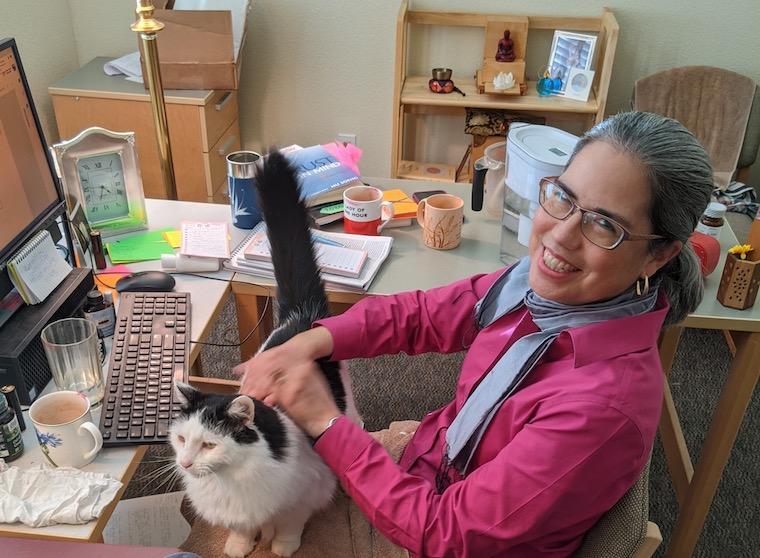
Social Media Apps Inspire Senior Lecturer To Create Student ‘Trust Pods’
By Tracy Seipel
Sarita Tamayo-Moraga finds success applying social media’s chat format to video discussion assignments.
When Santa Clara’s classes shifted online earlier this year, Sarita Tamayo-Moraga was among those SCU faculty worried about how students could engage in community for entirely remote classes.
“I feared that without a sense of belonging or connection to others in the class, they might feel lonely and fall through the cracks,” she says. Students, she knew, normally study together and help each other, but how were they to do that if they knew no one?
“Learning requires vulnerability and trust,” says Tamayo-Moraga, “so I think if students feel like they belong to a community while learning, they learn better.”
The Religious Studies senior lecturer’s concern for undergrads runs deep: for the past 11 years, she’s pulled double-duty as faculty director of the Unity Residential Learning Community, made up of first- and second-year students, and focused on the themes of diversity and civic engagement.
Or, as Tamayo-Moraga puts it: “Our theme is diversity as a catalyst for civic engagement, together and for each other,” she says of the approximately 225 students who live near her inside McLaughlin-Walsh Hall. “We focus on social justice programs.”
But in the aftermath of the pandemic, they would not be together anymore. Nor would new students enrolled in her classes, and Tamayo-Moraga particularly wondered how that group would connect to her, and to each other.
“I just had to think: what would work for them?”
She considered Zooming with the whole class, but decided that might not be the best format since her experience with Zoom classes had been varied.
Was there something else they might embrace?
She recalled something from living in the residence hall: students were constantly watching themselves and others on mobile apps like TikTok and Snapchat. Would a similar format prove effective with students in her Ways of Understanding Religion, or Zen in Theory and Practice courses?
For example, instead of writing up their responses to her questions or assigned readings about a subject like domestic terrorism, and how a person identifies their religion as the source of their violence or their compassion, could students do that in a chat format instead?
“I thought, this is so normal to them,” says Tamayo-Moraga.
So, she created “Trust Pods,” small groups of four to six students in each class who would have to report to each other for video discussion assignments twice a week all quarter long.
For example, when students do a video report on a class reading, they have to watch the videos of two to three other pod members and reply to their videos.
The format worked so well in the spring that she continued the practice into her summer and fall courses.
As one summer school student told her, having to record herself answering the prompt made her more engaged and brought the material alive.
“She said that in her other online classes, when she just had to write a response, it felt like she could do it with her eyes closed, and that did not engage her,” Tamayo-Moraga recalls.
In exams during the spring quarter, she also says students would mention each other’s videos while answering questions, something students have done this quarter as well.
“Anecdotally, I think the students’ own learning is supplemented by the other students,” she says. “And for me as an instructor, I felt like I got to know the students and their personality came through” in the videos.
Some trust pods are fully asynchronous, while others are synchronous with Tamayo-Moraga once or twice a week in 30-minute discussion groups. All groups sometimes do asynchronous discussion assignments. Her hope is that even if they were taking the class fully asynchronously, students would get to know each other through videos.
For the most part, it’s worked well, she says, and has been especially good for students who can think out loud and speak extemporaneously. She knows it's been harder for others who are not so inclined, so they will read their answers instead.
But Tamayo-Moraga believes posting these videos is a useful skill for everyone.
“It teaches them how to talk in front of others,” she says. “It doesn’t matter to me if it’s perfect. As long as they have thought about the assignment and can answer the questions.”
Moreover, she believes much of our world will continue to be online even after the pandemic, so students will have to do interviews online—as some have already—and increasingly may have to send videos of themselves answering questions.
So, learning from their fellow students when listening to their videos, says Tamayo-Moraga, “means that it stuck—or so I think.”